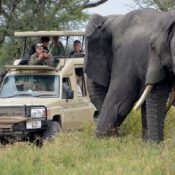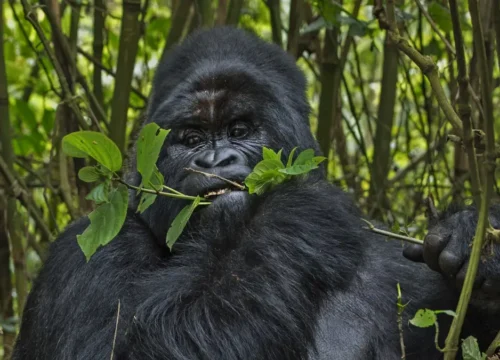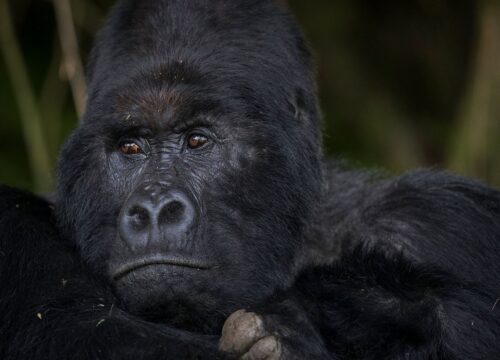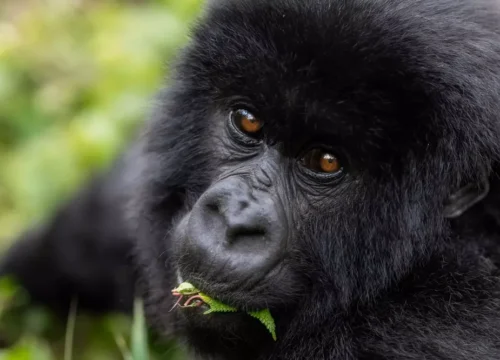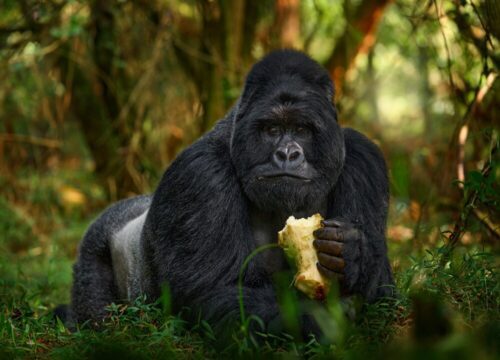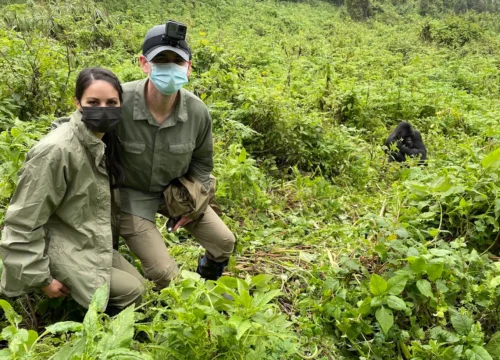Birding Safari in Africa
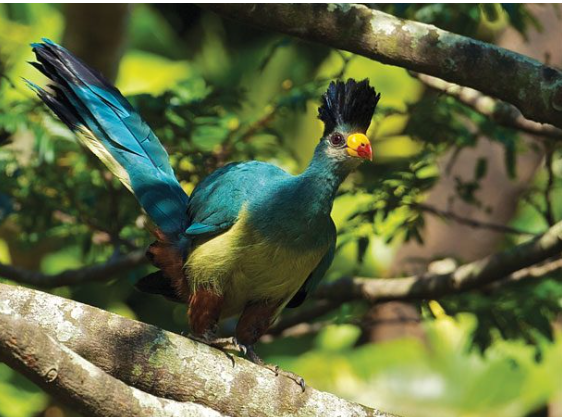
Birding in Uganda
Birding in Uganda is a captivating experience, as the country boasts a diverse range of avian species amid its stunning landscapes. With over 1,000 bird species, Uganda is a paradise for birdwatchers. The Bwindi Impenetrable Forest and Mgahinga Gorilla National Park are not only famous for gorilla trekking but also offer a chance to spot rare birds like the African Green Broadbill and Shelley’s Crimsonwing.
The Queen Elizabeth National Park, situated along the Albertine Rift, provides a unique birding experience with its varied habitats, including savannah, wetlands, and forests. Here, birders can encounter species like the African Fish Eagle, Grey-crowned Crane, and the shoebill stork.
Murchison Falls National Park, bisected by the Nile River, offers excellent birding opportunities, with sightings of the prehistoric-looking Shoebill and various water-associated species. The Kibale Forest National Park, known for its primates, is also a haven for bird enthusiasts, featuring the Green-breasted Pitta and African Grey Parrot.
Uganda’s diverse ecosystems contribute to its rich birdlife, making it a sought-after destination for both avid and novice birdwatchers. The welcoming local communities and experienced guides enhance the overall birding experience in this East African gem.
BIRD SPICES TO WATCH IN A BIRDING TRAIL WITH DETAILS
Shoebill (Balaeniceps rex): It is mostly found in Murchison Falls National Park, wetlands recognizable by its large shoe-shaped bill, this rare bird is a must-see. It often inhabits swampy areas, and sightings are particularly rewarding due to its unique appearance.
African Green Broadbill (Calyptomena viridis): This bird is mostly found in Bwindi Impenetrable Forest and Mgahinga Gorilla National Park. It is brilliantly colored bird with a vibrant green plumage, this species is known for its distinctive broad bill. It’s a challenge to spot but worth the effort for its stunning beauty.
Grey-crowned Crane (Balearica regulorum): This species can be traced in Queen Elizabeth National Park in large numbers. Uganda’s national bird, the Grey-crowned Crane, is characterized by its elegant appearance creatures.
African Fish Eagle (Haliaeetus vocifer): W e and distinctive golden crown. Grasslands and wetlands are prime spots for observing these graceful with its striking black and white plumage and a distinctive cry, the African Fish Eagle is a charismatic species often seen near lakes and rivers. Watch for its impressive fishing skills.
Shelley’s Crimsonwing (Cryptospiza shelleyi): This elusive bird is known for its deep crimson plumage. It inhabits the montane forests, and patient birders may be rewarded with glimpses of this rare and beautiful species.
Green-breasted Pitta (Pitta reichenowi): A colorful and secretive ground-dweller, the Green-breasted Pitta is a challenge to spot. Its distinctive green and orange plumage adds vibrancy to the forest floor.
Shoebill (Balaeniceps rex): Recognizable by its large shoe-shaped bill, this rare bird is a must-see. It often inhabits swampy areas, and sightings are particularly rewarding due to its unique appearance.
African Grey Parrot (Psittacus erithacus): It is widely known for its high intelligence and impressive mimicking abilities, the African Grey Parrot can be found in the lush forests. Listen for its diverse repertoire of sounds.
Exploring these birding trails in Uganda offers a chance to encounter a stunning array of avian species, each contributing to the rich tapestry of the country’s birdlife.
When is the best time for birding in Uganda
The best time for birding in Uganda is during the dry seasons, which typically occur from December to February and June to September. During these periods, the weather is more predictable, and birdwatchers can enjoy clearer skies and better visibility. The dry seasons also coincide with the breeding season for many bird species, making it an ideal time for observing courtship displays and nesting activities.
Migratory bird species are often present from November to April, adding to the diversity of birdlife. However, the specific timing can vary depending on the region within Uganda.
It’s advisable to check the local climate conditions and bird migration patterns for the specific areas you plan to visit, as Uganda’s diverse ecosystems may have variations in optimal birding times. Additionally, guided tours with experienced birding guides can enhance the overall birdwatching experience and help locate specific species.
WHERE TO GO FOR BIRDING
Bwindi Impenetrable Forest: Known for its population of mountain gorillas, Bwindi is also a prime birding destination. The forest is home to over 350 bird species, including the rare African Green Broadbill and Shelley’s Crimsonwing. Birding here often involves traversing challenging terrain, but the rewards are exceptional.
Murchison Falls National Park: Situated along the Nile River, Murchison Falls National Park offers a diverse range of habitats. Birdwatchers can spot the iconic Shoebill in the wetlands, along with African Fish Eagles, Goliath Herons, and numerous water-associated species. Boat safaris on the Nile provide a unique perspective for birding enthusiasts.
Queen Elizabeth National Park: This park is a birding paradise with over 600 species. The varied landscapes, including savannahs, wetlands, and forests, host a rich diversity of birds. Notable species include the Grey-crowned Crane, African Fish Eagle, and the elusive Shoebill. The Kazinga Channel boat cruise is a highlight for water bird sightings.
Kibale Forest National Park: Renowned for its primate population, Kibale is also a haven for birdwatchers. The Green-breasted Pitta, African Grey Parrot, and numerous forest-dwelling species can be found here. Guided walks through the lush forest provide opportunities to spot both primates and birds.
Semliki National Park: Situated in the Albertine Rift, Semliki is known for its lowland tropical rainforest and diverse birdlife. Birders can encounter the rare Shoebill, White-thighed Hornbill, and numerous other forest and swamp-associated species. The park’s hot springs add a unique element to the overall experience.
Kidepo Valley National Park: Located in northeastern Uganda, Kidepo Valley National Park is a less-explored gem. The park’s savannah landscapes are home to ostriches, Kori bustards, and various raptors. Birdwatchers can also enjoy cultural interactions with the Karamojong people.
Lake Mburo National Park: A smaller park but rich in biodiversity, Lake Mburo is home to over 300 bird species. Acacia woodlands and savannah plains diverse habitat for species like the African Finfoot, African Fish Eagle, and the rare Shoebill.
When planning a birding trip to Uganda, it’s beneficial to consult with local guides or tour operators to optimize the experience based on seasonal variations and specific bird species of interest.
What to know before you go for a birding trail
Before embarking on a birding trail, consider the following tips to enhance your experience:
Research Bird Species: Familiarize yourself with the bird species native to the region you’re visiting. Knowing what to look for will make your birdwatching more rewarding.
Choose the Right Season: Opt for the best time to visit based on bird migration patterns and breeding seasons. Dry seasons are often ideal, but this can vary by location.
Binoculars and Field Guide: Invest in good-quality binoculars and carry a field guide specific to the region. These tools are essential for identifying and observing birds in their natural habitat.
Clothing and Footwear: Wear neutral-colored, comfortable clothing suitable for the climate. Comfortable, sturdy footwear is crucial, especially if the trail involves varied terrain.
Local Guides: Consider hiring a local birding guide who knows the area and its birdlife intimately. Their expertise can significantly enhance your birdwatching experience.
Patience and Silence: Birding requires patience. Spend time quietly observing and listening. Avoid loud conversations or sudden movements that might scare away birds.
Respect Wildlife and Environment: Practice ethical birdwatching. Respect the natural habitat and the birds’ space. Avoid disturbing nests or wildlife.
Pack Essentials: Carry essentials like water, snacks, sunscreen, insect repellent, and a rain jacket. Staying comfortable allows you to focus on the birds.
Check Local Regulations: Be aware of any specific regulations or permits required for birding in the area. Follow responsible tourism practices and adhere to park rules.
Health Precautions: Depending on the location, check if any vaccinations or health precautions are recommended. Some birding trails may be in areas where certain health considerations are necessary.
Weather Preparedness: Be prepared for unexpected weather changes. Carry rain gear and protective covers for your equipment.
Record Keeping: Consider keeping a birding journal or using apps to record your sightings. This not only helps with identification but also creates a memorable record of your birding experiences.
By planning ahead and being well-prepared, you can make the most of your birding trail, enjoying the beauty of nature and the diverse avian life around you.
Items to carry on a birding Safari
When going on a birding safari, it’s essential to pack the right gear to enhance your experience. Here’s a checklist of items to consider bringing:
Binoculars: Invest in a good pair of binoculars with appropriate magnification and field of view for birdwatching.
Field Guide: Carry a bird field guide specific to the region you’re visiting to help identify species.
Spotting Scope: For distant or detailed observations, a spotting scope with a tripod can be beneficial.
Camera with Telephoto Lens: Capture memorable moments and bird sightings with a camera equipped with a telephoto lens.
Notebook and Pen: Keep a birding journal to record species sightings, behaviors, and any other observations.
Clothing: Wear neutral-colored, comfortable clothing suitable for the climate. Consider moisture-wicking fabrics and diverse. Sturdy, comfortable walking shoes or hiking boots are essential for varying terrains.
Backpack: Carry a lightweight backpack to hold your essentials during walks or hikes.
Water and Snacks: Stay hydrated by carrying a reusable water bottle and pack energy-boosting snacks.
Rain Gear: Depending on the season, bring a waterproof jacket or poncho to stay dry during unexpected rain.
Insect Repellent: Protect yourself from mosquitoes and other insects with a reliable insect repellent.
Sunscreen: Apply sunscreen to protect your skin from prolonged sun exposure.
First Aid Kit: Pack a basic first aid kit with essentials like bandages, pain relievers, and any necessary medications.
Travel Adapters and Chargers: Ensure your electronic devices, such as cameras or smartphones, are charged. Bring travel adapters if needed.
Headlamp or Flashlight: Useful for early morning or evening birding excursions and navigating trails.
Personal Identification and Documentation: Carry identification, travel documents, and any required permits.
Birding Apps: Download birding apps for real-time bird identification and additional information.
Small Umbrella: A compact umbrella can be handy for both rain and shade.
Travel Pillow and Blanket: If your safari involves long drives, a travel pillow and blanket can make the journey more comfortable.
By packing these essentials, you’ll be well-prepared to enjoy your birding safari and make the most of the unique birdwatching opportunities in the chosen destination.
WHERE TO STAY ON A BIRDING SAFARI IN UGANDA
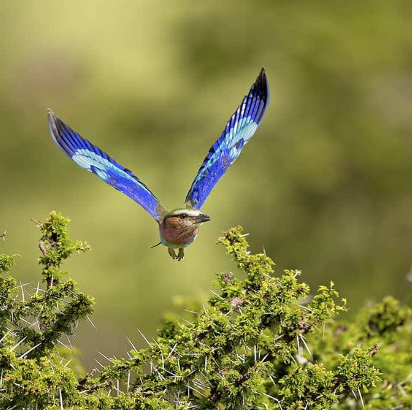
Uganda offers various lodges strategically located near prime birding destinations. Here are some lodges known for accommodating birding enthusiasts:
Bwindi Lodge: Situated on the edge of Bwindi Impenetrable Forest, this lodge offers comfortable accommodation with stunning views. Birders can explore the forest and its avian inhabitants easily.
Primate Lodge Kibale: Nestled in the heart of Kibale Forest, this lodge provides a perfect base for birdwatchers exploring the diverse avian life of the region.
Mweya Safari Lodge: Overlooking the Kazinga Channel, Mweya Safari Lodge offers a luxurious stay with excellent birding opportunities, including water-associated species.
Paraa Safari Lodge: Positioned near the Victoria Nile, this lodge provides a comfortable stay for birders exploring the diverse birdlife of Murchison Falls National Park.
Semliki Safari Lodge: This lodge offers a unique experience near the Semliki Forest and hot springs, catering to birders interested in the rich bird diversity of the region.
Apoka Safari Lodge: Nestled in the remote Kidepo Valley, Apoka Safari Lodge offers a luxurious retreat for birdwatchers exploring the park’s savannah landscapes.
Birdnest @Bunyonyi Resort//opportunities to spot waterfowl and other species in the vicinity.
Mihingo Lodge: Located around Lake Mburo National Park. This eco-friendly lodge is located in the acacia woodland near Lake Mburo, offering a comfortable stay for birdwatchers exploring the park’s diverse birdlife.
Some of our tour Packages
1 Day Jinja Ultimate tour Experience
1 Day White Water Rafting in Jinja
3 Days Bwindi Impenetrable National Park Gorilla Trekking Tour
3 Day Birding Safaris and Photography in Uganda
3 Day Safari to Queen Elizabeth National Park
3 Day fly in Gorilla Trekking Safari from Masai Mara
3 Day Grand Gorilla Trekking Safari
4 Day Chimpanzee and Gorilla Trekking Safari
Recent Posts
Last Minute Deals
Quick booking process
+49 1575 4711313



